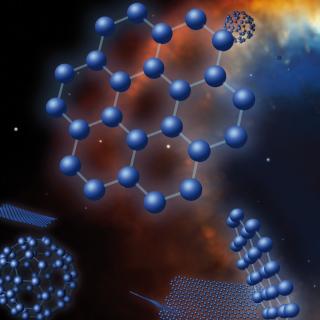Bibcode
Huertas-Roldán, T.; Alcolea, J.; García-Hernández, D. A.; Tafoya, D.; Fonfría, J. P.; Díaz-Luis, J. J.; Manchado, A.; Bujarrabal, V.; Barzaga, R.; Gόmez-Muñoz, M. A.
Bibliographical reference
Astronomy and Astrophysics
Advertised on:
8
2025
Journal
Citations
0
Refereed citations
0
Description
Context. The circumstellar environments of planetary nebulae (PNe) are remarkably chemically rich astrophysical laboratories, proving useful for studies of the ionization of atoms and the formation of simple and complex molecules. The new generation of high-sensitivity receivers opens up the possibility to carry out the deep observations needed to unveil the weak atomic and molecular spectra lying in the millimeter (mm) range. Aims. The main goal of this work is to study the emission lines detected in the spectra of the bright C-rich PNe IC 418 and NGC 7027 and to identify all those emission features associated with the radio recombination lines (RRLs) of light elements. We aim to analyze the RRLs detected for each source, model the sources, and derive their physical parameters. This work has allowed us to provide the most complete and updated catalog of RRLs in space. Methods. We present the results of our very deep line survey of IC 418 and NGC 7027 carried out at 2, 3, and 7 mm with the IRAM 30m and the Yebes 40m radio telescopes. We compared these observational data sets with synthetic models produced with the radiation transfer code Co3RaL. Results. Our observations toward the target PNe reveal the presence of several H and He I RRLs at mm wavelengths in the spectra of IC 418 and NGC 7027 and also of He II RRLs in the spectrum of NGC 7027. Many of these lines had remained undetected until now due to their weakness and the lack of high-sensitivity observations at these frequencies. The data also confirm the absence of molecular emission toward IC 418, above a detection level of ~3 mK [Tmb]. Conclusions. These mm observations represent the most extended RRL line survey of two C-rich PNe carried out thus far, with most of the lines reported for the first time. These extremely complete catalogs evidence the importance of high-sensitivity observations and are expected to be very helpful in the line identification process in mm observations, particularly for molecular species in the vicinity of ionized environments that are still unknown or poorly characterized.
Related projects

Nucleosynthesis and molecular processes in the late stages of Stellar Evolution
Low- to intermediate-mass (M < 8 solar masses, Ms) stars represent the majority of stars in the Cosmos. They finish their lives on the Asymptotic Giant Branch (AGB) - just before they form planetary nebulae (PNe) - where they experience complex nucleosynthetic and molecular processes. AGB stars are important contributors to the enrichment of the
Domingo Aníbal
García Hernández